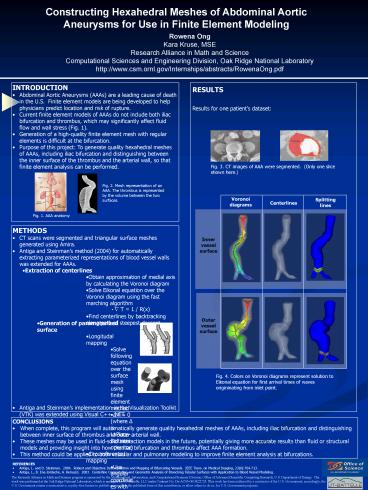METHODS - PowerPoint PPT Presentation
1 / 1
Title:
METHODS
Description:
... free license to publish or reproduce the published form of this ... Fig. 3. CT images of AAA were segmented. ( Only one slice shown here.) Thrombus ... – PowerPoint PPT presentation
Number of Views:14
Avg rating:3.0/5.0
Title: METHODS
1
Constructing Hexahedral Meshes of Abdominal
Aortic Aneurysms for Use in Finite Element
Modeling
Rowena Ong Kara Kruse, MSE Research Alliance in
Math and Science Computational Sciences and
Engineering Division, Oak Ridge National
Laboratory http//www.csm.ornl.gov/Internships/abs
tracts/RowenaOng.pdf
- INTRODUCTION
- Abdominal Aortic Aneurysms (AAAs) are a leading
cause of death in the U.S. Finite element models
are being developed to help physicians predict
location and risk of rupture. - Current finite element models of AAAs do not
include both iliac bifurcation and thrombus,
which may significantly affect fluid flow and
wall stress (Fig. 1). - Generation of a high-quality finite element mesh
with regular elements is difficult at the
bifurcation. - Purpose of this project To generate quality
hexahedral meshes of AAAs, including iliac
bifurcation and distinguishing between the inner
surface of the thrombus and the arterial wall, so
that finite element analysis can be performed.
RESULTS Results for one patients dataset
Fig. 3. CT images of AAA were segmented. (Only
one slice shown here.)
Fig. 2. Mesh representation of an AAA. The
thrombus is represented by the volume between the
two surfaces.
Fig. 1. AAA anatomy
- METHODS
- CT scans were segmented and triangular surface
meshes generated using Amira. - Antiga and Steinmans method (2004) for
automatically extracting parameterized
representations of blood vessel walls was
extended for AAAs. - Extraction of centerlines
- Obtain approximation of medial axis by
calculating the Voronoi diagram - Solve Eikonal equation over the Voronoi diagram
using the fast marching algorithm - ? T 1 / R(x)
- Find centerlines by backtracking along path of
steepest descent
- Generation of parameterized surface
- Longitudal mapping
- Solve following equation over the surface mesh
using finite element method - ? f 0 (where ? is LaPlace-Beltrami operator)
- Circumferential mapping
- Use angular coordinates with respect to the
centerline - Generate hexahedral mesh
- Use sweeping algorithm
- CONCLUSIONS
- When complete, this program will automatically
generate quality hexahedral meshes of AAAs,
including iliac bifurcation and distinguishing
between inner surface of thrombus and outer
arterial wall. - These meshes may be used in fluid-solid
interaction models in the future, potentially
giving more accurate results than fluid or
structural models and providing insight into how
the iliac bifurcation and thrombus affect AAA
formation. - This method could be applied to both vascular and
pulmonary modeling to improve finite element
analysis at bifurcations.
- REFERENCES
- Antiga, L. and D. Steinman. 2004. Robust and
Objective Decomposition and Mapping of
Bifurcating Vessels. IEEE Trans. on Medical
Imaging, 23(6)704-713. - Antiga, L., B. Ene-Iordache, A. Remuzzi. 2003.
Centerline Computation and Geometric Analysis of
Branching Tubular Surfaces with Application to
Blood Vessel Modeling.
The Research Alliance in Math and Science program
is sponsored by the Mathematical, Information,
and Computational Sciences Division, Office of
Advanced Scientific Computing Research, U.S.
Department of Energy. The work was performed at
the Oak Ridge National Laboratory, which is
managed by UT-Battelle, LLC under Contract No.
De-AC05-00OR22725. This work has been authored by
a contractor of the U.S. Government, accordingly,
the U.S. Government retains a nonexclusive,
royalty-free license to publish or reproduce the
published form of this contribution, or allow
others to do so, for U.S. Government purposes.































